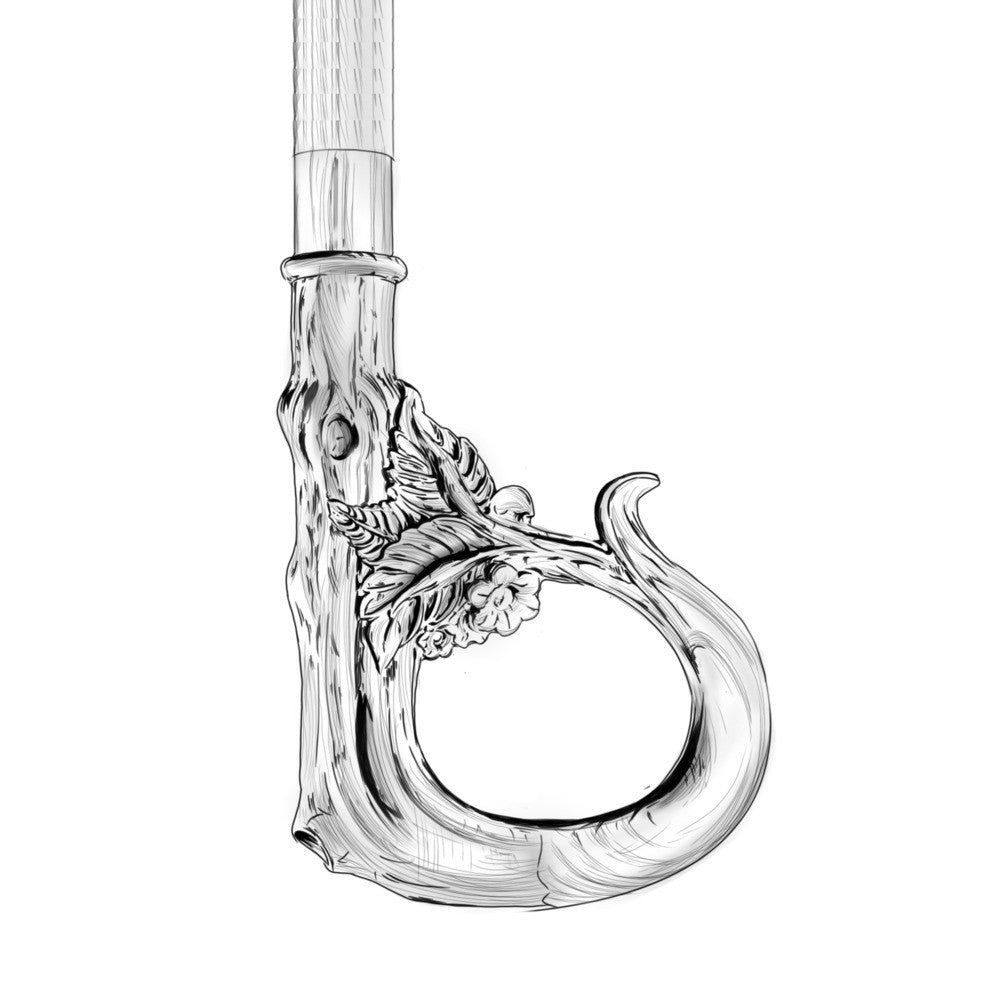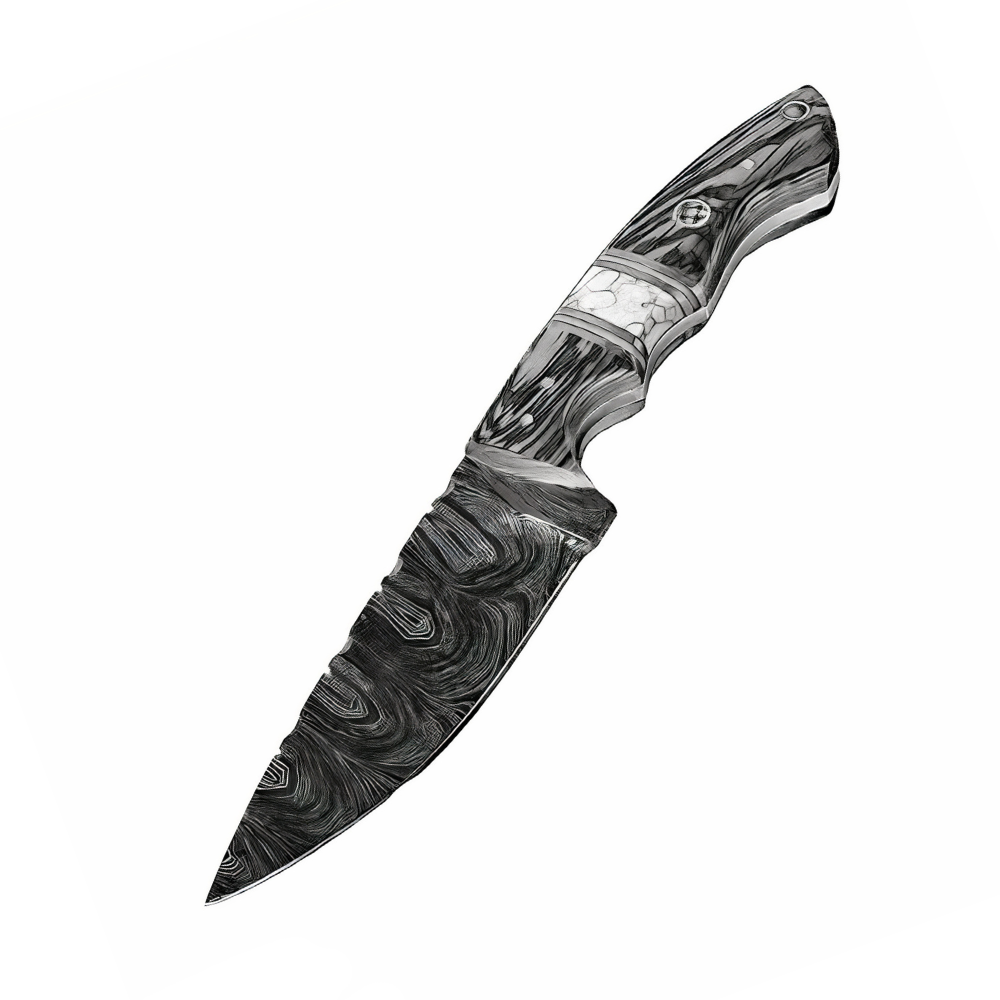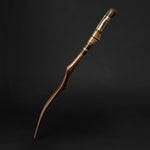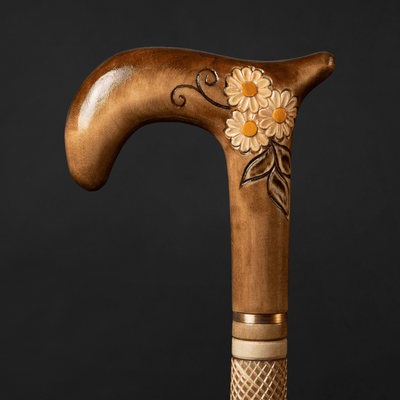You have no items in your shopping cart.
Recent Posts
-
The Art of Christmas Design: Walking Canes That Celebrate the Season in Style
-
How an Ergonomic Walking Cane Handle Prevents Hand and Wrist Strain?
-
How to Walk With a Cane Correctly to Avoid Back or Shoulder Strain?
-
5 Common Mistakes People Make When Buying a Walking Cane (and How to Avoid Them)
-
How to Choose a Walking Cane That Reflects Your Personality (Not Just Your Needs)?
-
Walking Canes That Match Formalwear for Weddings and Events
MOST POPULAR NOW
14
Apr
Mountain climbing is an exhilarating experience that challenges the limits of human endurance. It is not for the faint-hearted, and it requires a lot of physical and mental strength. Many people go mountain climbing to push themselves to their limits and to experience the beauty of nature. However, mountain climbing is also a dangerous activity that can cause serious injuries or even death. That is why it is important to use the right equipment, including walking sticks. In this article, we will discuss the importance of using walking sticks for mountain climbing and the brief history of walking sticks for this purpose.
The best walking sticks for mountain climbing
Why use walking sticks for mountain climbing?
Walking sticks, also known as trekking poles, are a valuable tool for mountain climbers. They offer many benefits, including:
-
Stability: Walking sticks provide added stability and support on uneven terrain. They help distribute your weight evenly and reduce the strain on your legs, making it easier to maintain your balance.
-
Decreased impact: Walking sticks help reduce the impact on your knees, ankles, and hips when walking downhill. They act as shock absorbers, which can prevent injury and decrease pain.
-
Increased endurance: Walking sticks can help you conserve energy and increase your endurance. By using your arms to help propel yourself forward, you can reduce the strain on your legs and lungs, allowing you to go further and climb higher.
-
Safety: Walking sticks can be used as a tool to test the stability of the ground before you step on it. They can also be used to defend against wild animals or snakes.

Brief history of walking sticks for mountain climbing
Walking sticks have been used for centuries, dating back to ancient times. In the 19th century, walking sticks became more popular for mountaineering, especially in Europe. The first known use of walking sticks for mountain climbing was by Jean-Jacques Rousseau in 1760. However, it was not until the 20th century that they became widely used.
Walking sticks have come a long way since their early days. Today, they are made of lightweight materials such as aluminum or carbon fiber, which makes them easier to carry and use. They also come in various designs and styles, from basic to advanced.
In conclusion, walking sticks are a valuable tool for mountain climbers. They offer many benefits, including stability, decreased impact, increased endurance, and safety. Walking sticks have been used for centuries, and they continue to be an important part of mountain climbing equipment today. If you are planning on going mountain climbing, be sure to invest in a good pair of walking sticks to help you navigate the terrain safely and comfortably.
Benefits of using walking sticks for mountain climbing
Mountain climbing is a challenging and thrilling activity that requires a lot of physical and mental strength. To make the experience safer and more enjoyable, it's important to use the right equipment, including walking sticks. In this article, we will discuss the benefits of using walking sticks for mountain climbing.
-
Stability and balance
Walking sticks, also known as trekking poles, offer added stability and balance on uneven terrain. They provide a wider base of support and can help keep you from slipping or losing your balance. When ascending or descending steep slopes, walking sticks can help you maintain your footing and reduce the risk of falls.
-
Reduces impact on joints
Mountain climbing can put a lot of stress on your knees, hips, and ankles. Walking sticks help reduce the impact on your joints by distributing your weight more evenly. This can help prevent pain, swelling, and other injuries that can occur from repeated impact on hard surfaces.
-
Better traction and grip
Walking sticks also provide better traction and grip on slippery or loose surfaces such as snow, gravel, or rocks. They can help you navigate difficult terrain with more confidence and ease. With walking sticks, you can push off the ground with more force and take longer strides, which can help conserve energy and make the climb less strenuous.
-
Helps distribute weight
Walking sticks help distribute your weight more evenly between your upper and lower body. This can help reduce fatigue and increase your endurance. By using your arms to help propel yourself forward, you can take some of the strain off your legs and lungs, allowing you to climb higher and go further.
In conclusion, walking sticks are a valuable tool for mountain climbers. They provide stability and balance, reduce the impact on joints, offer better traction and grip, and help distribute weight more evenly. If you're planning on going mountain climbing, be sure to invest in a good pair of walking sticks to make your climb safer, more comfortable, and more enjoyable.
Factors to consider when choosing walking sticks for mountain climbing
Walking sticks, also known as trekking poles, are an essential tool for mountain climbing. They provide stability, balance, and support while reducing the impact on your joints. However, choosing the right walking sticks can be overwhelming with so many options available on the market. In this article, we will discuss the factors to consider when choosing walking sticks for mountain climbing.
-
Material
The material of the walking stick is a crucial factor to consider. Walking sticks can be made of various materials, including aluminum, carbon fiber, and composite materials. Aluminum is a popular choice for its durability and affordability. Carbon fiber is lightweight and offers excellent shock absorption, but it can be more expensive. Composite materials combine the best of both worlds, offering durability and lightweight construction.
-
Weight
The weight of the walking stick is another essential factor to consider. You don't want a walking stick that is too heavy, as it will tire you out more quickly. Lightweight walking sticks are ideal for long hikes and climbs. When shopping for walking sticks, look for models that weigh between 9 and 14 ounces.
-
Adjustability
Adjustability is an essential factor to consider when choosing walking sticks for mountain climbing. Walking sticks that are adjustable can be customized to your height, making them more comfortable to use. They also offer versatility, allowing you to adjust the length of the walking stick depending on the terrain.
-
Grip
The grip of the walking stick is another crucial factor to consider. Look for walking sticks with ergonomic grips that are comfortable to hold. The grip should be slip-resistant and absorb moisture to prevent your hands from slipping during use. Cork and foam are popular materials used for walking stick grips.
-
Shock absorption
Shock absorption is another critical factor to consider when choosing walking sticks for mountain climbing. Walking sticks with good shock absorption can help reduce the impact on your joints and prevent fatigue. Look for walking sticks with built-in shock absorbers or suspension systems.
-
Tip
The tip of the walking stick is another crucial factor to consider. Walking sticks come with different tips, including rubber, carbide, and steel. Rubber tips are ideal for hiking on hard surfaces, while carbide tips are better for rocky terrain. Steel tips are durable and offer excellent traction but can be slippery on smooth surfaces.
In conclusion, choosing the right walking sticks for mountain climbing is essential for a safe and comfortable climb. Consider the material, weight, adjustability, grip, shock absorption, and tip when shopping for walking sticks. With the right walking sticks, you can enjoy a more comfortable, safer, and enjoyable mountain climbing experience.
Types of walking sticks for mountain climbing
Walking sticks, also known as trekking poles, are an essential tool for mountain climbing. They provide stability, balance, and support while reducing the impact on your joints. There are several types of walking sticks available on the market, each with its advantages and disadvantages. In this article, we will discuss the types of walking sticks for mountain climbing.
-
Single walking stick
Single walking sticks, as the name suggests, are individual walking sticks that are used one at a time. They are ideal for hikers who prefer to use only one walking stick or for those who want to save weight. Single walking sticks are often adjustable and can be customized to your height. They are also easy to pack and store when not in use.
-
Pair of walking sticks
Pair of walking sticks, also known as trekking poles, are two walking sticks that are used together. They are ideal for hikers who want extra stability and support. Pair of walking sticks can help you maintain your balance on uneven terrain and reduce the impact on your joints. They are often adjustable and come with ergonomic grips and wrist straps for comfort.
-
Folding walking sticks
Folding walking sticks are ideal for hikers who want a compact and portable walking stick. They are often made of lightweight materials and can be folded down to a small size for easy packing and storage. Folding walking sticks are also adjustable and come with comfortable grips.
-
Telescopic walking sticks
Telescopic walking sticks, also known as collapsible walking sticks, are adjustable walking sticks that can be customized to your height. They are made of lightweight materials and can be collapsed down to a small size for easy packing and storage. Telescopic walking sticks often come with comfortable grips and wrist straps.
In conclusion, there are several types of walking sticks available for mountain climbing, each with its advantages and disadvantages. Single walking sticks are ideal for those who want to save weight, while pair of walking sticks are perfect for extra stability and support. Folding walking sticks are compact and portable, while telescopic walking sticks are adjustable and collapsible. Consider your needs and preferences when choosing the type of walking stick that is right for you.

How to properly use walking sticks for mountain climbing?
Walking sticks, also known as trekking poles, are an essential tool for mountain climbing. They provide stability, balance, and support while reducing the impact on your joints. However, it is important to know how to properly use walking sticks to maximize their benefits. In this article, we will discuss how to properly use walking sticks for mountain climbing.
-
Proper height adjustment
The first step in using walking sticks is to adjust them to the proper height. The general rule of thumb is to adjust the walking sticks so that your elbow is at a 90-degree angle when holding the grip. This height adjustment will ensure that you can use the walking sticks to their fullest potential and minimize the strain on your arms and shoulders.
-
Proper grip technique
The grip is an essential part of using walking sticks. You should hold the grip lightly, with your fingers wrapped around the grip and your thumb on top. This grip will provide stability and support while allowing your hands to remain relaxed. You should also make sure that the wrist strap is properly adjusted and snug around your wrist to prevent the walking stick from slipping out of your hand.
-
Proper swing technique
The swing is the motion used to move the walking sticks while walking. The swing should be smooth and controlled, with the walking sticks moving in a natural motion. The walking sticks should be placed slightly in front of your body, and you should swing them back and forth in time with your stride. You should also make sure that the walking sticks are not swinging too high or too low, as this can cause strain on your arms and shoulders.
-
Proper placement technique
The placement is the motion used to plant the walking sticks on the ground. The walking sticks should be placed at an angle, with the tip of the walking stick touching the ground first, followed by the heel of your foot. This placement will provide stability and support while reducing the impact on your joints. You should also make sure that the walking sticks are placed on firm and stable ground to prevent slipping or tripping.
-
Proper stride technique
The stride is the motion used to move your feet while walking. You should take short and controlled steps, with your feet landing squarely on the ground. Your walking sticks should move in time with your stride, providing stability and support while reducing the impact on your joints. You should also make sure to maintain a steady pace and avoid over-striding, as this can cause strain on your joints.
In conclusion, using walking sticks for mountain climbing is an effective way to provide stability, balance, and support while reducing the impact on your joints. To properly use walking sticks, you should adjust them to the proper height, use a proper grip technique, use a proper swing technique, use a proper placement technique, and use a proper stride technique. With these techniques, you can maximize the benefits of walking sticks and enjoy a safer and more comfortable mountain climbing experience.
How to maintain walking sticks for mountain climbing?
Walking sticks for mountain climbing can be a valuable investment for anyone who wants to enjoy the outdoors while staying safe and comfortable. However, in order to keep them in good condition, it's important to properly maintain them. Here are some tips on how to maintain your walking sticks for mountain climbing.
- Cleaning: After each use, it's important to clean your walking sticks thoroughly. Use a soft cloth or sponge with warm water and mild soap to remove any dirt or debris from the shaft and grip. Be sure to dry them off completely with a clean towel to prevent rust or corrosion.
- Storage: When not in use, it's important to store your walking sticks properly. Keep them in a cool, dry place to prevent any damage from moisture. Avoid storing them in direct sunlight, as this can cause the materials to deteriorate over time. If you have folding or telescopic walking sticks, be sure to collapse them fully and store them in their original carrying case.
- Repair: If you notice any damage or wear on your walking sticks, it's important to repair them as soon as possible. Common issues include loose or broken parts, bent shafts, or damaged tips. Depending on the severity of the damage, you may be able to repair them yourself or you may need to take them to a professional. In any case, don't continue to use damaged walking sticks as this can put you at risk for injury.
In conclusion, proper maintenance of walking sticks is essential for ensuring their longevity and continued performance on the mountain trails. By following these tips for cleaning, storage, and repair, you can keep your walking sticks in top shape and enjoy many safe and enjoyable climbs for years to come.
Tips for choosing the right walking sticks for mountain climbing
When it comes to choosing the right walking sticks for mountain climbing, there are several factors to consider. Here are some tips to help you make the best decision.
-
Determine your needs and preferences: Think about the type of terrain you will be climbing and your individual needs and preferences. Consider your height and the amount of weight you will be carrying. Determine if you need a single or pair of walking sticks and if you prefer a certain material or grip style.
-
Test out walking sticks: It's important to test out walking sticks before purchasing them. Many outdoor stores will have walking sticks available for you to try out. This will allow you to see how they feel and if they provide the support and stability you need.
-
Research different brands: Do your research and read reviews from other mountain climbers. Look for brands that specialize in outdoor equipment and have a good reputation for quality and durability. Consider factors such as weight, adjustability, and shock absorption.
-
Consider budget: Walking sticks for mountain climbing can vary in price depending on the materials and features. Determine your budget and look for walking sticks that meet your needs within your price range.
In conclusion, choosing the right walking sticks for mountain climbing is essential for ensuring your safety and comfort on the trails. By determining your needs and preferences, testing out different options, researching brands, and considering your budget, you can make an informed decision and choose the walking sticks that will provide you with the support and stability you need on your climbs.
Frequently asked questions (FAQs)
-
Do I really need walking sticks for mountain climbing? While walking sticks are not mandatory for mountain climbing, they can provide several benefits such as improved stability, balance, and reduced joint impact. They can also help with weight distribution and provide better traction on tricky terrain. Ultimately, it is up to the individual climber to decide if walking sticks are necessary for their climb.
-
How many walking sticks do I need for mountain climbing? The number of walking sticks needed for mountain climbing depends on personal preference and the type of terrain being climbed. Some climbers prefer using a single walking stick, while others find it more helpful to use a pair. It's important to test out different options and find what works best for you.
-
Can I use trekking poles instead of walking sticks for mountain climbing? Trekking poles can be a suitable alternative to walking sticks for mountain climbing. They are similar in design and offer many of the same benefits such as improved stability and weight distribution. It's important to choose poles that are specifically designed for mountain climbing and test them out before use.
-
How do I choose the right height for my walking sticks? To choose the right height for your walking sticks, stand up straight and measure from the ground to your armpit. This measurement will give you an approximate height for your walking sticks. It's important to adjust the height based on the terrain and incline of the climb.
-
How do I clean my walking sticks? Cleaning your walking sticks is important for maintaining their longevity. Use a damp cloth to wipe down the surface of the sticks, paying attention to any dirt or debris on the tips. For stubborn stains, use a mild soap and water solution. Once cleaned, allow the walking sticks to air dry and store them in a cool, dry place.

Conclusion
Walking sticks are an essential piece of equipment for any mountain climber. They offer a wide range of benefits, including stability, balance, reduced joint impact, better traction and weight distribution. In addition to the benefits, there are several factors to consider when choosing the right walking sticks, including material, weight, adjustability, grip, shock absorption, and tip.
When it comes to the types of walking sticks, there are single walking sticks, a pair of walking sticks, folding walking sticks, and telescopic walking sticks. Each has its own advantages and disadvantages, depending on the climber's needs and preferences.
Proper usage of walking sticks is essential to ensure maximum benefits. This includes adjusting the height properly, using the correct grip and swing technique, and placing them in the right position. Maintenance is also crucial for the longevity of walking sticks, including regular cleaning, proper storage, and repairs when necessary.
In choosing the right walking sticks, one should determine their needs and preferences, test out walking sticks, research different brands, and consider budget. This can help ensure the perfect fit for the climber.
In conclusion, walking sticks are a vital tool for mountain climbers. They offer numerous benefits, and with proper usage and maintenance, they can last for years. By considering the factors mentioned above, climbers can choose the right walking sticks and make their climb safer and more enjoyable.
Also Purchased
-
Beige Walking Cane for Ladies Chamomile Flower, Wooden Walking Stick
Introducing our beautiful Beige Walking Cane for Ladies with Chamomile Flower, a Wooden Walking Stick that is hand carved and handmade, making it both pretty and unique. This walking cane...$90.00$79.50 -
Exotic Burl Wood Walking Cane – Fashionable Artisan Stick
A sculptural statement in deep, oceanic blue — this walking cane is more than a support accessory, it's wearable art. Meticulously hand-shaped from stabilized burl wood, the handle evokes the...$425.00 -
ArtWalkingSticks™ MAGIC Walking Cane, Handmade - Make to Order
This piece of art is created for those who value details. We make one of a kind, handcrafted wood and resin canes. Our Wooden Canes are completely unmatched in creativity....$430.00 -
Umbrella with Eagle Handle, Fashion Umbrella For Men
Make a bold and fashionable statement with our Umbrella with Eagle Handle - a unique and functional accessory designed for men. The striking eagle handle is the highlight of this...$325.00 -
Fashionable Lion Shoehorn Long Handle, Pearly Brown Shaft, Handmade
Introducing our Fashionable Lion Shoehorn, a handcrafted, long-handled shoe horn with a pearly brown shaft that's both stylish and practical. The intricate Lion design adds a touch of elegance to...$240.00 -
ArtWalkingSticks™ MAGIC Red Walking Cane - Unisex, Handmade
This piece of art is created for those who value details. We make one of a kind, handcrafted wood and resin canes. Our Wooden Canes are completely unmatched in creativity....$425.00
































